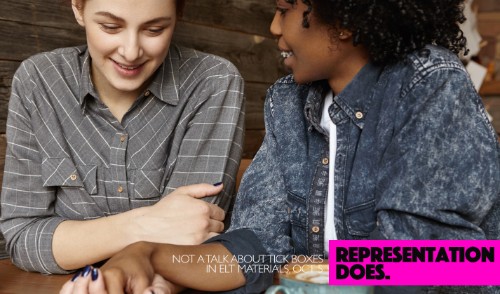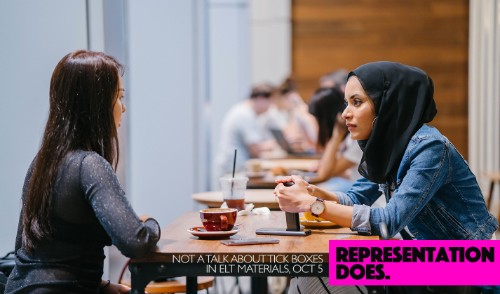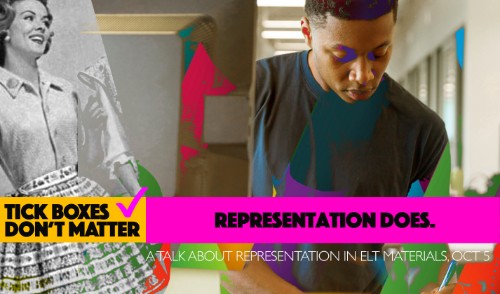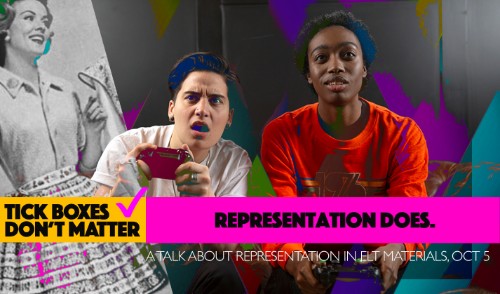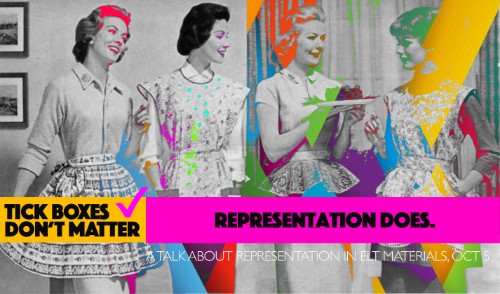I’m very excited to have been asked to give a plenary talk at the upcoming World Teachers’ Day Web Conference on Saturday, October 5, hosted by IATEFL and British Council! This fantastic opportunity emerged in early August, when Shaun Wilden (IATEFL Digital Committee as one of the coorganisers) approached me via email to see if I were interested in talking about something along the lines of my This talk will make you gay (or your materials anyway) at #iatefl2019. Immediately I said yes.
Besides the fact that the annual web conference IATEFL organises is a formidable collection of talks and accessible freely to all who pre-register and recorded for members, I’m all for grabbing a hold of any platform I can to further talk about aspects of and issues in our profession that are important to me. My friend, Paula Rebolledo, whose work includes supporting and encouraging teachers as researchers, instilled that sentiment in me from our time at the BBELT2019 conference in Mexico City last February, especially when the topics we are interested in aren’t given as prominent or frequent a platform as some others are.
I’ve been talking about LGBTQIA2 representation in ELT though for the better part of 2 years. It took me a long time to come to the point in my career where I chose not to simply accept the way things are in this regard, but now that I’m here… I thought it might be interesting to see a little into the back-end of my experiences of giving talks and how they can progress from one to another for me.
Over the past decade or so that I’ve had the privilege of gaining experience as a speaker; it’s become apparent that one talk as is generally has a life-span of about 12-18 months for me. The two talks I’ve done involving Academic Reading Circles went for about this long, for example, with perhaps an webinar exception here and there. At that point, I generally get tired and it’s served its purpose. I wonder if other speakers find this too.
At that point, my interest moves onto something new that I want to discuss and share with others from my research and experience or I learn more about whatever I’m speaking of and that informs more a shift in perspective about the purpose of the talk and the angle from which I approach it.
I first talked about the othering of LGBTQIA2 in our profession in November 2017 at the TESL Ontario Conference in Toronto. At this point, the rhetorical title Do we other LGBTQ in ELT? was more a reiteration of the invisibility of our community within our materials to a local audience and trying to raise awareness as to how we got this way based on attitudes from all sorts of stakeholders in ELT: teachers, publishers, materials writers, training programs, learners, managers, and funders. I used this talk again at the #toscon18 (May 2018) and from it at a few private school and training program talks with local teachers.
Where this talk to me seemed to fall short was production of any particular change. I’d been to a few talks (very few, btw) over the years involving LGBTQ topics and like most, identifying the problem of invisibility was the main establishment. So for the Image Conference in Athens in Oct 2018, I wanted to change things up to include both awareness raising and actual activities that could be used by teachers. In Video Oxymorons: inclusive and othering approaches to marginalised groups, I brought in sample videos that included both straight and gay couples to illuminate preconceptions about inclusivity within a listening/speaking activity. We also looked at the difference between inclusion and othering similarly to how I did in the previous talk, but followed it up with workshopping how other videos and language learning activities could be worked into an LGBTQIA2 inclusive activity. I repeated this session at the TESOL France Colloquium the following month.
Around this time, the call for speakers for IATEFL Conference in Liverpool was due. This #iatefl2019 one (This talk will make you gay (or your materials anyway)) emerged from an idea I had following this progression towards the practical from theoretical. I really wanted to use that opportunity to look at a lesson as a whole, and ideally make it available to anyone. While I don’t use coursebooks these days really, I’m aware that some teachers (perhaps most?) throughout the world do. Yet as our invisibility (and really, the whole PARSNIPS patch) has been identified in part due to a publisher policy, seeing an actual unit that included the inclusive pedagogy meant that I needed to make one. After all, we can complain all we want, but eventually someone needs to just do it. So I put together the proposal of creating both a sample coursebook unit and some non-coursebook materials, which I would discuss the rationale behind and demonstrate within this talk.
And so, at IATEFL Inclusive Practices & Special Education Needs SIG Showcase Day, I gave this talk, which showed two approaches (heavily on ‘normalisation’; minorly on ‘disruption’) to an audience of 150 teachers and materials writers, most of whom were my peers and colleagues. Then I gave a slightly modified version of it as a plenary at BCTEAL Conference in Vancouver. Now that I’ve also published the sample coursebook unit online, I’ll be giving it again at ELT Malta Conference during the IATEFL Materials Writing SIG strand on Oct 17-18 with even more concrete description.
This brings me back now to the upcoming plenary that began this post: World Teachers’ Day Web Conference on October 5. I have been very fortunate in the last year that my #iatefl2019 talk has sparked interest in a healthy number of groups: it’s provided me some consultation work in national curriculum and teacher training, guest blog posts, potential journal articles, lots of healthy insightful discussion with new and old friends that’s helped me see things differently, and even contact from a few publisher representatives. And of course, this upcoming plenary: In Tick boxes don’t matter. Representation does., part of the talk will involve principles of the talks I’ve mentioned, but I want to do two additional things:
- highlight how these principles and our discussions about the tenets of inclusivity and diversity lead to possible tick box meaninglessness; and
- discuss how representation in ELT materials should be considered to avoid this tick box culture in favour of meaningful engagement with the materials we use so diligently.
Lofty goals for an hour, I know. I really hope you’ll join me and all the other quality talks available during the day.
>>> Register here if you haven’t already.
Please follow me on Twitter, Instagram, or Facebook.
Plenary promo video
Plenary abstract
I once asked English language teachers across the globe, “Collectively across a whole term, how well do you think people of your society are represented in your materials?” Only 5% suggested everyone, while 57% claimed most materials only included one type. Guess who…
In principle, most of us want to foster spaces where our learners feel included within our teaching practice. We can see evidence of this from the increasing frequency of the terms ‘inclusion’ and ‘diversity’ in social media discussions, conference talks, and organisational statements. In reality, we may not realize how our identities and those presumed of our learners impact our approaches to doing so, particularly in our materials choices and creation. It can be very tempting to include an LGBTQIA+ couple smiling at each other, tick the ‘inclusive practice’ box on our task list, and feel good about ourselves. So….
Do we represent our learners in our materials appropriately? Yes with an ‘if’, No with a ‘but’.
Does representation really matter in an ELT context? Yes (without ‘ifs’ or ‘buts’)!
In this talk, I’d like to explore these two questions and their answers in some depth by walking through the social spectrum of ELT materials from whitewashed to an array of brilliant colours. In doing so, these will illustrate how representation of learners, teachers, and the people of our societies more broadly can be accomplished effectively and appropriately to empower rather than (unintentionally) oppress. Tick boxes won’t ever look the same.

